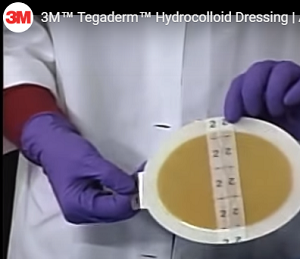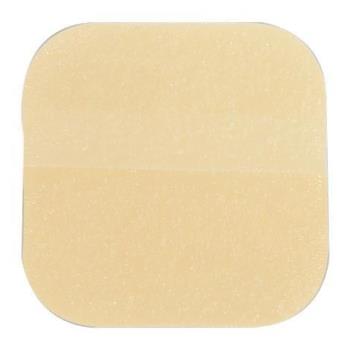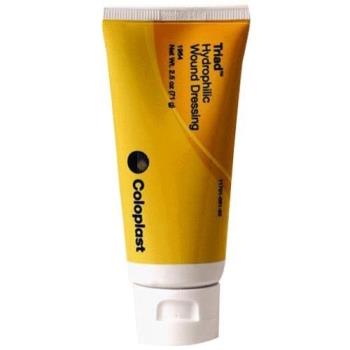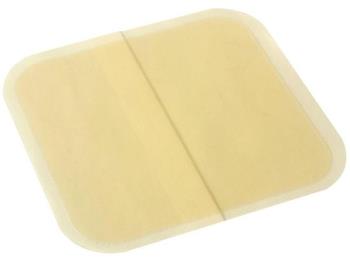

Hydrocolloid dressing
They are easy to apply to the wound and come in a variety of shapes and sizes for different types of wounds. Hydrocolloid dressing can also be used with venous compression. In addition, they can often promote faster healing because they: Provide a moist environment which allows body enzymes to help heal.
Demonstration Videos
SPECIFICATIONS
hydrocolloid dressing is an opaque or transparent[1] dressing for wounds. A hydrocolloid dressing is biodegradeable, breathable, and adheres to the skin, so no separate taping is needed.
The active surface of the dressing is coated with a cross-linked adhesive mass containing a dispersion of gelatin, pectin and carboxymethyl cellulose together with other polymers and adhesives forming a flexible wafer. In contact with wound exudate, the polysaccharides and other polymers absorb water and swell, forming a gel. The gel may be designed to drain, or to remain within the structure of the adhesive matrix.[2]
The moist conditions produced under the dressing are intended to promote fibrinolysis, angiogenesis and wound healing, without causing softening and breaking down of tissue. The gel which is formed as a result of the absorption of wound exudate is held in place within the structure of the adhesive matrix. Most hydrocolloid dressings are waterproof, allowing normal washing and bathing.[3]
Contents
UsesEdit
Learn more
This section needs more medical references for verification or relies too heavily on primary sources.
Hydrocolloid dressings are used to treat uninfected wounds. Dressings may be used, under medical supervision, even where aerobic infection is present; the infection should be treated appropriately.
The dressing is applied to a cleaned wound. Hydrocolloid patches are sometimes used on the face for acne. Smaller sizes are used on acne, not only to get rid of acne, but to avoid acne scars. They are also used to secure nasogastric tubes or CPAP masks to the patient’s face. Hydrocolloid dressings are used for pressure ulcers (also known as bed sores). They are used in the treatment of eczema, to seal steroid ointment underneath and to provide a barrier against scratching.
EffectivenessEdit
The results of meta-analyses indicate no significant difference in healing rates between hydrocolloid dressings and other dressings (including simple dressings) for venous ulcers,[4] or for diabetic foot ulcers.[5]
There is tentative but unclear evidence for hydrocolloid dressings for superficial and partial thickness burns.[6] Hydrocolloid dressings were, however, superior to other substrates (i.e., alginate, film, gauze, hydrofiber, silicone) for treating skin graft donor sites. [7]
USER MANUAL
FREQUENTLY ASKED QUESTIONS
Helpful Hints
Hydrocolloid dressings are known to have a unique design. They include an adhesive compound containing gel-forming agents like gelatin or sodium carboxymethylcellulose. The adhesive compound is laminated on a film or foam made from polyurethane. Dressings so formed are absorbent, flexible, waterproof, and self-adhering. Hydrocolloid wound dressings provide insulation and a moist wound environment conducive to healing. They use the moisture and enzymes of the body to hydrate the wound bed for faster healing.
Hydrocolloid Dressings – Work as a Primary or Secondary Dressing
Hydrocolloid dressings are available in paste, gel, or sheet form and may be used as a primary or a secondary dressing. The paste or gel dressing needs a secondary dressing for proper security. When used as a secondary dressing, the wound surface should be in the contact of an alginate or a gelling cellulose fibre.
Hydrocolloid wound dressings consist of a hydrocolloid matrix containing materials like pectin, gelatin, and carboxymethylcellulose. They are an absorbent, opaque, waterproof, and adherent wafer that carries hydrophilic colloidal particles in a hydrophobic polymer. When the dressing comes in contact with the wound surface, the fluid is absorbed by the hydrophilic particles. These particles swell, liquefy, and convert into a gel over the wound surface, enhancing autolytic debridement. Hydrocolloid bandages are impermeable to oxygen, water vapor, and carbon dioxide.
Hydrocolloid Dressing Benefits
- Self-adherent
- Does not adhere to moist wound base
- Impermeable to gases, bacteria, water vapour, water, and many other external contaminants
- Provides moist wound environment that promotes new tissue formation
- Minimal disruption to healing
- Waterproof property lets users take shower with it
- Easy to apply to wound surface
- Quick exudate absorption
- Reduces pain
- May be used with venous compression products
- Can be worn for several days without being changed
What is a Hydrocolloid Dressing used for?
Hydrocolloid dressing is used to treat different types of wounds. Best results are seen when the wound is uninfected:
- Partial or full thickness wounds
- Granular and necrotic wounds
- Low to moderate drainage wounds
- Surgical incisions
- Pressure injuries
- Leg ulcers
Top-Selling Hydrocolloid Dressings
HPFY offers an extensive collection of hydrocolloid dressings that includes dressings that come in the form of gel, paste, or sheet and are transparent, absorbent, anti-microbial, adherent, or non-adherent.
 |
 |
 |
| Convatec Hydrocolloid Wound Dressing | Coloplast Triad Hydrophilic Wound Dressing | Medline Square Hydrocolloid Dressing |
Hydrocolloid Dressing Uses
- Use a saline solution to clean the wound.
- Pat dry the skin around the wound with the help of a sterile gauze.
- Measure the dressing to allow about a margin of one inch from the wound edge.
- Remove the paper liner and apply the hydrocolloid dressing in the center of the wound. Use a rolling motion to smooth out the edges.
- Do not overstretch or apply too much tension because it can result in blistering, skin trauma or breaks to the surrounding skin.
- After applying the dressing, hold it in place with the help of your palms. The warmth of your hand will mold the dressing to the skin.
- If the hydrocolloid dressing does not have its own border, use an adhesive tape, under cast padding, netting, or retention bandage to secure it.
How to remove Hydrocolloid Dressing?
- Gently press down the skin near one edge of the dressing.
- Lift up that dressing edge until all the adhesive is free.
- Continue to lift around other edges until all the adhesive is detached from the skin.
- Now peel off the dressing carefully from the wound in the direction of the hair growth.
- If a new dressing is needed, follow the above stated steps to reapply a new hydrocolloid dressing.
When to change Hydrocolloid Dressing?
- The wounds covered by hydrocolloid bandages are moist and protected, and need not be cleaned daily.
- In fact, the wounds will heal faster if they are not cleaned or exposed to air regularly.
- Hydrocolloid dressings will need a change every 3 to 7 days.
- Sometimes, if the hydrocolloid dressing is leaking from the edges or it is 70% full with the wound exudate, it can be changed earlier.
Contraindications of Hydrocolloid Dressing
Hydrocolloid bandage is usually contraindicated for:
- Dry wounds or burns
- Wounds having exposed tendon or bone
- Wounds with heavy exudate
- Infected wounds
- Wounds with fragile periwound skin
- Deep narrow sinus tracts
- Tunneling wounds
Now, when you are familiar with the benefits and usage of hydrocolloid dressings, HPFY offers you a wide product range from top-selling hydrocolloid dressing brands like DuoDERM, Comfeel, Exuderm, Restore, etc.
Disclaimer: All content found on our website, including images, videos, infographics and text were created solely for informational purposes. Our content should never be used for the purpose of diagnosis or treatment of any medical conditions. Content shared on our websites is not meant to be used as a substitute for advice from a certified medical professional. Reliance on the information provided on our website as a basis for patient treatment is solely at your own risk. We urge all our customers to always consult a physician or a certified medical professional before trying or using a new medical product.
RELATED ITEMS
My Wound Doctor
MyWoundDoctor Home-based, health care consumers – patients – frequently suffer from hard-to-heal Read more...
Central-line-or-picc-line-dressing-change
Central Line Dressing Change A central line (PICC, port, Hickman or other Read more...
How to prepare and administer TPN Instructions
TPN Administered TPN administration into a vein, generally through a Read more...
Prospera Wound Vac Instructions
Prospera PRO series negative pressure wound care The negative pressure wound therapy Read more...
Medela (Invia) Liberty Instructions
Invia Liberty Wound Care – Medela The Invia Liberty delivers Read more...
Invia Motion Negative Pressure Wound Therapy
Invia Motion Negative Pressure Wound Therapy The pump provides the convenience of a personal Read more...
KCI NPWT System | V.A.C.Ulta Application
KCI NPWT System | V.A.C.Ulta Application Designed for use with trusted V.A.C.® Read more...
V.A.C.Via™ Negative Pressure Wound Therapy
V.A.C.Via™ Therapy Device A mobile, ultra-portable, single patient use, disposable V.A.C.® Therapy Device Read more...
Interactive Wound Dressings Instructions
Interactive Wound Dressings The ideal dressing material should provide a moist environment Read more...
Sterile Dressing Wound Care Change Instructions
Follow these steps to remove your dressing: Wash your hands thoroughly Read more...
Hydrocolloid Wound Dressings Instructions
Hydrocolloid dressing They are easy to apply to the wound and come Read more...
Foam Wound Dressings Instructions
Composite Wound Dressings They are wound covers that combine physically distinct Read more...
Flushing a port a cath Instructions
Flushing a Port a Cath Normal saline is used to flush fluids Read more...
Dressing Change & Flush Port-a-Cath Instructions
Dressing Change & Flush Port-a-Cath A port-a-cath is a device that is usually Read more...
Access Port-a-cath Instructions
Port-a-cath A port-a-cath, also referred to as a port, is Read more...
Central Line Dressing Change Instructions
Central Line Dressing Change A central line (PICC, port, Hickman or other Read more...
Caring for Peripherally Inserted Central Catheter (PICC)
Peripherally inserted central catheter (PICC) PICC stands for Peripherally Inserted Central Catheter. Read more...
Bard Medical STATLOCK® PICC Plus Stabilization Device
StatLock® PICC Plus Stabilization Device The StatLock® PICC Plus Stabilization Device offers Read more...
Biopatch – PICC line Dressing Change
PICC line dressing change (Biopatch) Shows how to set up Read more...
PICC line Blood Draw Instructions
Central Line Blood Draw Central lines are IV's which allow medications to be Read more...
 PATIENT LEARNING CENTER
PATIENT LEARNING CENTER

